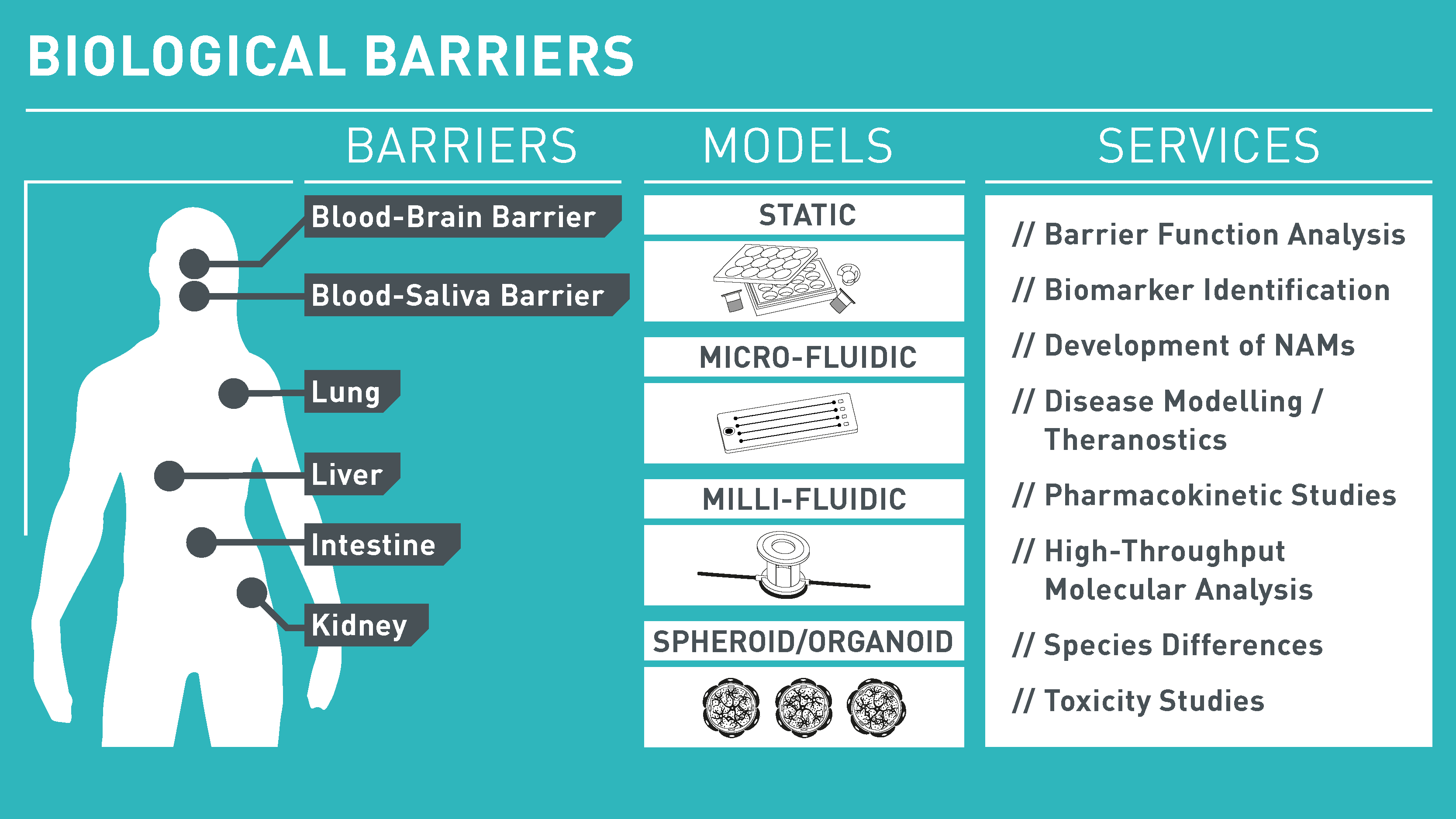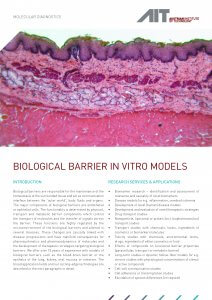BIOLOGICAL BARRIER
IN VITRO MODELS
Biological barriers are responsible for the maintenance of the homeostasis of the surrounded tissue and act as communication interface between the “outer world”, body fluids and organs. The major components of biological barriers are endothelial or epithelial cells. The functionality is determined by physical, transport and metabolic barrier components which control the transport of molecules and the transfer of signals across the barrier. These functions are highly regulated by the microenvironment of the biological barriers and altered in several diseases. These changes are causally linked with disease progressions and have manifold consequences for pharmacokinetics and pharmacodynamics of molecules and the development of therapeutic strategies targeting biological barriers. We offer over 15 years of experience with models of biological barriers such as the blood-brain barrier or the epithelia of the lung, kidney, oral mucosa or intestine. The broad application fields and our cutting-edge technologies are described in the next paragraphs in detail.

Research Services & Applications
- Biomarker research – identification and assessment of relevance and causality of novel biomarkers
- Disease models for e.g. inflammation, cerebral ischemia
- Development of novel (human) disease models
- Development and evaluation of novel therapeutic strategies
- Drug transport studies
- Nanoparticle, liposomal or protein (incl. biopharmaceutics) transport studies
- Transport studies with chemicals, toxins, ingredients of cosmetics or biomarker molecules
- Toxicity studies with chemicals, environmental toxins, drugs, ingredients of either cosmetics or food
- Effects of compounds on functional barrier properties (paracellular, transport or metabolic barrier)
- Long-term studies in dynamic hollow-fiber models for e.g. chronic studies with physiological concentrations of stimuli or active compounds
- Cell-cell communication studies
- Cell adherence or transmigration studies
-
Elucidation of species differences (on request)
Technology used
- Cell culture in vitro models of the blood-brain barrier and the epithelia of the lung, kidney, oral mucosa or intestine based on tumor cells, immortalized cells or primary cells from different species (mouse, rat, porcine, human). Monocultures with endothelial or epithelial cells as well as co- and multi-culture models with barrier-adjacent cell types are used dependent on the application.
Novel models based on human pluripotent stem cells (hiPSC) are available (blood-brain barrier, further are under development). - Model set-ups: Well plates in several formats (6, 12, 24, 96); Transwell models with different pore sizes (0.4, 1, 3, 8 μm) and made of different materials, coated or non-coated dependent on the cells; dynamic hollow-fiber models with adjustable flow rates to apply physiological relevant shear stress for long-term studies; spheroid models (under development and upon request).
- Hypoxia chambers to apply oxygen down to concentrations of 0.1% to mimic diseases such as ischemia.
- Molecular analysis and characterizations of the physical (paracellular), transport (ABC and SLC-transporter) and metabolic barrier with established methods using paracellular markers, transendo/epithelial electrical resistance (TEER) measurements, qPCR, western blotting, immunofluorescence microscopy, flow cytometry, uptake studies, transporter activity studies, etc.
High-throughput technologies such as in-house designed Barrier Chip for high-throughput qPCR with over 120 barrier -relevant targets on the Biomark Fluidigm platform. These chips could be loaded with 96 targets and 96 samples revealing 9216 qPCR data points within one run.
References:
Krasemann S et al., The blood-brain barrier is dysregulated in COVID-19 and serves as a CNS entry route for SARS-CoV-2. Stem Cell Reports. 2022 Feb 8;17(2):307-320. doi: 10.1016/j.stemcr.2021.12.011.
Lin GC et al., Optimization of an oral mucosa in vitro model based on cell line TR146. Tissue Barriers. 2020 Apr 2;8(2):1748459. doi: 10.1080/21688370.2020.1748459.
Gerhartl A et al., The pivotal role of micro-environmental cells in a human blood-brain barrier in vitro model of cerebral ischemia: functional and transcriptomic analysis. Fluids Barriers CNS. 2020 Mar 5;17(1):19. doi: 10.1186/s12987-020-00179-3.
Ramme AP et al., Autologous induced pluripotent stem cell-derived four-organ-chip. Future Sci OA. 2019 Sep 10;5(8):FSO413. doi: 10.2144/fsoa-2019-0065.
Additional Services
Studies with biological barrier in vitro models could be combined with several DNA/RNA/protein screening platforms established at the Competence Unit Molecular Diagnostics: Protein and peptide array services, “catalogue assays” (Luminex, ELISA), OLINK’s – oncology, inflammation, cardiovascular panels etc., autoantibody platform, epigenetic/DNA-methylation analysis platforms.
In addition, studies with the in vitro models of biological barriers could be expanded and combined with in vivo small animal PET studies at the AIT Competence Center Health & Bioresources.
If you are interested, we would like to invite you to contact us to speak about further details and possibilities.
Background
We offer over 15 years of experience with models of biological barriers such as the blood-brain barrier or the epithelia of the lung, kidney, oral mucosa or intestine. Biological barriers are responsible for the maintenance of the homeostasis of the protected tissue and act as communication interface between the “outer world”, body fluids and organs. The major components of biological barriers are endothelial or epithelial cells. The function of biological barriers is highly regulated by its microenvironment such as adjacent cells or also physical forces such as shear stress of applied by blood flow. For biomarker research biological barriers play a pivotal role to understand the origin of the biomarker and consequently the causality between the found biomarker and the correlated disease status. On the one hand molecular biomarkers from tissues have to cross biological barriers in order to be detectable within body fluids, on the other hand biological barriers could be sources for biomarkers itself.
The functionality of biological barriers is altered in several diseases, for example changes of the blood-brain barrier are reported for almost every known CNS-related disease (Alzheimer’s disease, stroke, traumatic brain injury, multiple sclerosis, epilepsy, pain, brain tumour, Parkinson disease, bacterial and viral infections, ALS, hypertension, lysosomal storage diseases). Currently, it is discussed that functional alterations are causally linked to disease progressions, and therefore several therapeutic strategies targeting biological barriers are under development. These barrier changes can also alter the pharmacokinetics and pharmacodynamics of drugs or drug candidates. Therefore, it is essential to work with validated disease models already in the drug development phase in order to obtain reliable preclinical data or to use the models to investigate and understand the underlying mechanisms. Moreover, it is important to consider species differences, therefore human models of biological barriers are needed to improve the data translatability from animal models to the human via e.g. human in vitro models of biological barriers. The variety of applications and research fields using in vitro models of biological barriers is huge.
CONTENT

PD DR WINFRIED NEUHAUS
